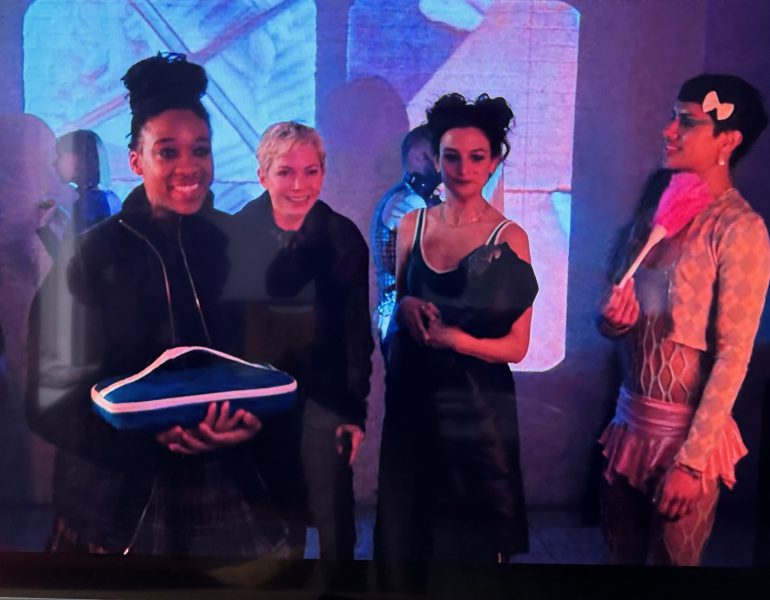
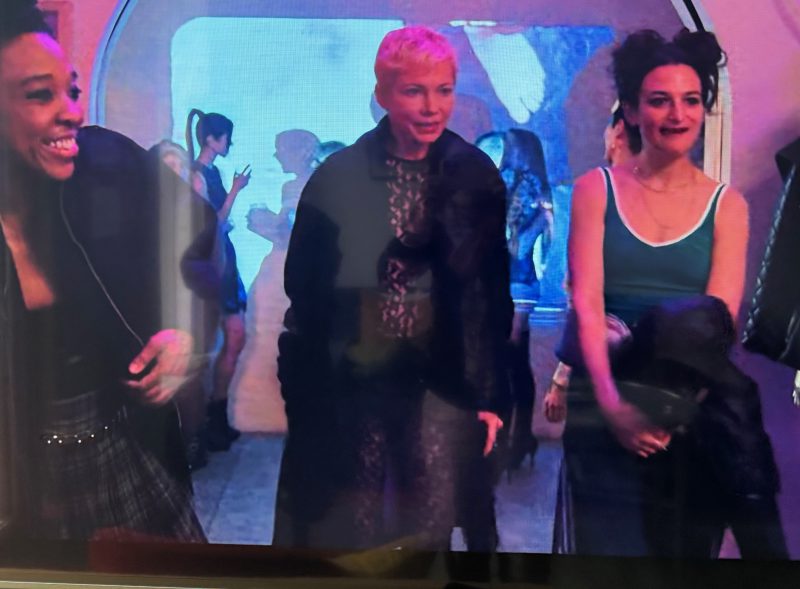
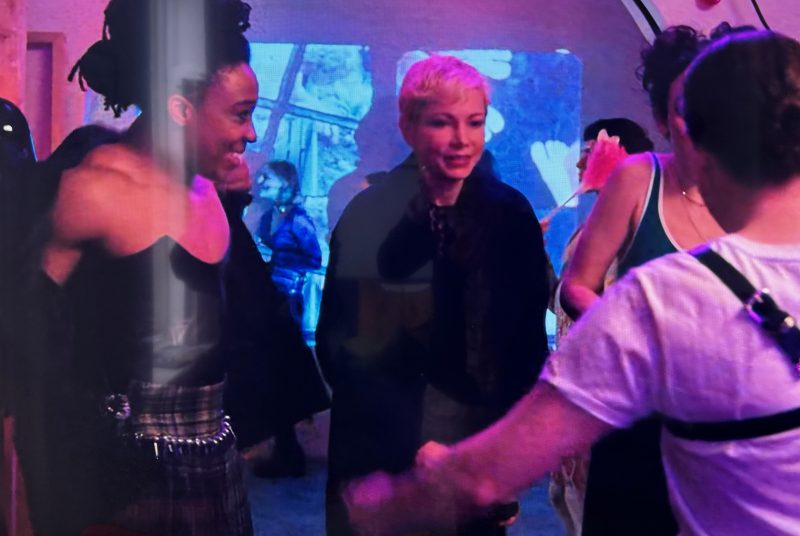
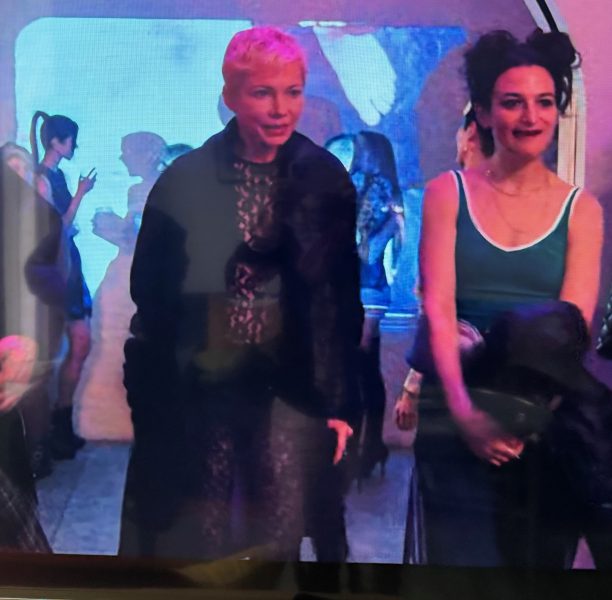
Lynne Sachs’ Drawn and Quartered is featured on Episode 4 of FX TV mini series Dying for Sex starring Michelle Williams and Jenny Slate in a scene in a sex club. Premiering April 2025.
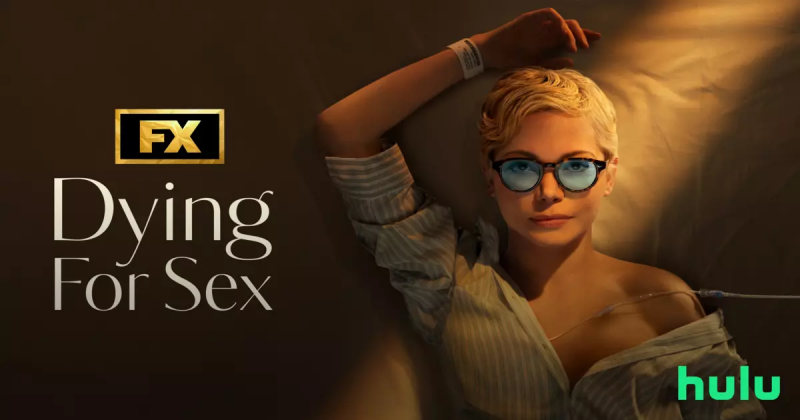
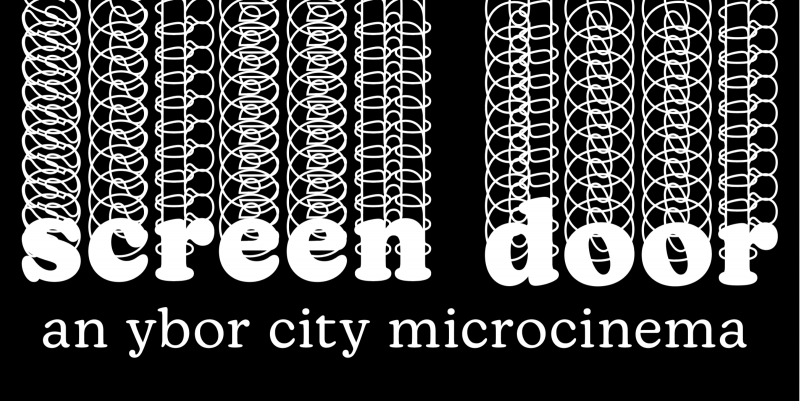
FILM ABOUT A FATHER WHO & Short Films by Mark Street and Lynne Sachs
Ybor Microcinema
July 22 & 23, 2023
Ybor Microcinema:
https://ybormicrocinema.org/
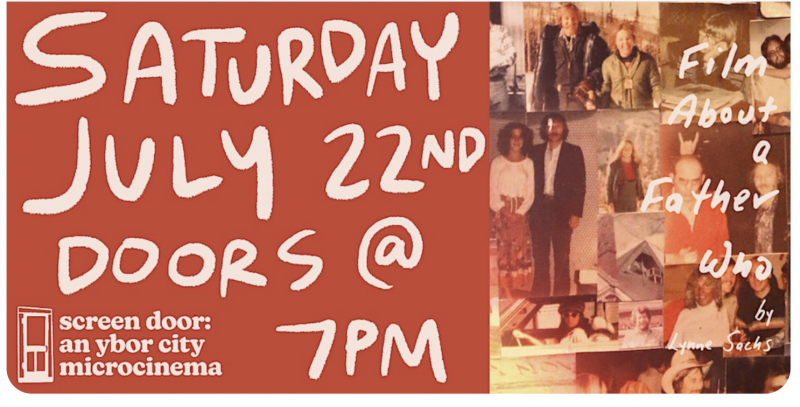
Sachs has created an indelible work that, like those within it, perseveres by way of honesty and love.
Date and time
Saturday, July 22 · 7 – 10pm EDT
Location
Screen Door Cinema Kress Annex 1624 East 7th Avenue Tampa, FL 33605
About this event
In Horace’s Odes, one among many texts where this sentiment endures, the Roman poet wrote, “For the sins of your fathers you, though guiltless, must suffer.” It’s hardly an esoteric dictum, but nevertheless it’s duly reflected in experimental filmmaker Lynne Sachs’ wholehearted documentary portrait of her father, Ira Sachs Sr. Something of a longstanding work-in-progress, the film draws from decades of footage shot by Sachs, her father, and her filmmaker brother, Ira Sachs Jr. (whose own 2005 film FORTY SHADES OF BLUE was inspired by the same so-called “Hugh Hefner of Park City”), plus others, documenting not just the sybaritic “hippie-businessman” patriarch, but also his numerous descendants. Sachs’ knotty chronicle reveals that her father has a total of nine children with several different women, two of whom the other siblings found out about only a few years back. (The film opens with Sachs brushing her elderly father’s hair, working out a particularly unpleasant snarl. “Sorry, dad,” she says. “There’s just one part that’s very tangly.” The irony is faint and benevolent, but present even so.) Sachs considers the enveloping imbroglio from her own perspective, but also takes into account the viewpoints of her eight siblings, her father’s ex-wives (including her own mother) and girlfriends, plus Ira’s mother, a gracefully cantankerous old woman in a certain amount of denial over her son’s wanton predilections and the role she played in his dysfunction. FILM ABOUT A FATHER WHO—the title an homage to Yvonne Rainer’s FILM ABOUT A WOMAN WHO…—is comprised of footage recorded between 1965 and 2019 and shot on 8mm, 16mm, VHS, Hi8, Mini DV, and digital; the fusion of all this material (by editor Rebecca Shapass) ranks among the most astounding use of personal archives that I’ve ever seen. It all exists in a state between documentary and home-movie footage, a paradigm that aptly reflects the conflict between reality and perspective, and the uncomfortable middle-ground that bisects the two. Sachs’ work often features her family, but this feels like an apotheosis of her autobiographical predisposition, likewise a question—why do the sins of the father linger?—and an answer. Among the most affecting scenes are round table discussions between the siblings where they consider revelations about their father and the implications of his actions. These scenes are heartrending not for their sadness, but rather for their naked honesty; it’s not just a film about a father who, but also a film about a love that defines a family. Sachs’ filmography is centered on infinite poetic quandaries (in voice over, she explores some of them here, such as when she muses on her father’s profession as a developer in Utah: “What happens when you own a horizon?”) and this feels like a logical conclusion to a lifetime of such profound impasses, though I’ve no doubt she’ll continue to probe life and its enigmas in a similarly masterful fashion. For all the suffering on display, Sachs has created an indelible work that, like those within it, perseveres by way of honesty and love.
_________
Screen Door Microcinema celebrates the works of Lynne Sachs, along with her feature documentary, ‘A Film About a Father Who’
Followed by a special Q/A with Aditya Sudhakaran on Saturday, July 22, 2022
In a career spanning over 30 years of filmmaking, Lynne Sachs shares her collections of compassion with an introspective lens that often centers and returns to the filmmaker herself. As in many of her films, Sachs’ personal life and struggle are deeply connected with the themes she presents. In her latest work, ‘A Film about a Father Who,’ Sachs presents an intense study of her charismatic father and unravels the strands of his lasting impacts on their family.
There is something rhythmic and inexplicably resonant when a filmmaker can point the camera at a subject and examine familial connections and tensions just with someone’s face, body and words. For Sachs, her filmmaking affirms that it’s not just the characters who should be on an adventure, but the filmmaker as well. With her latest film, Sachs skillfully persists in the sensation of being fragile while voicing that to be an artist is to be possibly caught in the conundrum of failure.
Lynne Sachs is no stranger to the Tampa Bay area and joins us for a special Q/A at Screen Door Microcinema. Her moving image work ranges from short experimental films to hybrid live performances to essay films, which have screened, won awards or been included in retrospectives at New York Film Festival, Museum of Modern Art, Sundance, Oberhausen, Viennale, Sheffield Doc/Fest.
In the spirit of great documentary filmmakers, Screendoor presents a screening of Werner Herzog’s Fitzcarraldo followed by Tampa’s own Les Blank and his study of the making of Werner Herzog’s feature in Burden of Dreams the following week.
By Aditya Sudhakaran
‘A Film about a Father Who’ plays at Screen Door Microcinema on Saturday, July 22 followed by a Q/A with Lynne Sachs. A collection of short films by Sachs’ and her spouse, filmmaker Mark Street plays Sunday, July 23.
Various Short Films introduced by the directors themselves.
Date and time
Sunday, July 23 · 3 – 6pm EDT
Location
Screen Door Cinema Kress Annex 1624 East 7th Avenue Tampa, FL 33605
The XY Chromosome Project follows the career paths of Lynne Sachs and Mark Street. To follow this path is to trace a blueprint on devotion. Working both together and individually for the past 30 years, each artist has carved out their own niche without the obvious influences of being married. They part ways to be left alone to their own creations. It is the respect for the other’s work that bonds them. Left alone, their work could not be more different. Lynne’s work is cerebral and emotional. As seen in her full length films “Your Day is My Night” and “Tip of My Tongue”. She collages the art of storytelling by layering stunning visuals while swimming between reality and performance.
Mark is the experimental film hero, a pioneer in film manipulation, an encyclopedia in the world of experimental films. His film work is solely connected to what is possible in the organics of film manipulation. They celebrate experimentation in its truest form. Yet both come down on the same line when it matters most. The line of captivation which as any artist knows is the hardest to achieve.
__________
Screen Door Cinema and Flexfest are hosting Lynne Sachs & Mark Street live and in-person at Screen Door this Sunday at 3pm! 16mm & digital program
Sunday 7/23/23
Doors 3pm
Showtime 3:30
THE X/Y CHROMOSOME PROJECT:
short films by Lynne Sachs and Mark Street
**an in-person conversation with Lynne Sachs & Mark Street follow the screening**
In 2010, Mark Street and Lynne Sachs created The XY Chromosome Project, an umbrella for their collaborative ventures. Together they have produced an array of collaborative installations, performances, and two-dimensional art works. To follow this path is to trace a blueprint on devotion. Working both together and individually for the past 30 years, each artist has carved out their own niche without the obvious influences of being married. They part ways to be left alone to their own creations. It is the respect for the other’s work that bonds them. Left alone, their work could not be more different. Lynne’s work is cerebral and emotional. She collages the art of storytelling by layering stunning visuals while swimming between reality and performance. Mark is the experimental film hero, a pioneer in film manipulation, an encyclopedia in the world of experimental films. His film work is solely connected to what is possible in the organics of film manipulation. They celebrate experimentation in its truest form. Yet both come down on the same line when it matters most. The line of captivation which as any artist knows is the hardest to achieve.” (Stephen Lipuma, Court Tree Gallery)
BLUE MOVIE, Mark Street, 1994, 5min, 16mm
DRAWN AND QUARTERED, Lynne Sachs, 1987, 4 min., silent, 16mm
ECHO ANTHEM, Mark Street, 1991, 8min, sound, 16mm
WINTERWEHEAT, Mark Street, 1989, 8min. 16mm
EPISTOLARY: LETTER TO JEAN VIGO, Lynne Sachs, 2021, 4 min., digital
GEORGIC FOR A FORGOTTEN PLANET, Lynne Sachs, 2007, 8 min., digital
THE GRAIN OF BELFAST, Mark Street, 2022, 6min Super 8 to digital
DRIFT AND BOUGH, Lynne Sachs, 2015, 6 min., 16mm to digital
CLEAR ICE FERN, Mark Street, 2023, 12min, Super 8 to digital
FLUTTER, Mark Street, 2022, 14min, digital

“Where do framed bodies go?”
by Lynne Sachs
Analog Cookbook Issue #7 – Analog Erotica
June 28, 2023
https://analogcookbook.com/

Analog Cookbook Issue #7 – Analog Erotica
University of North Carolina Press
Edited by Kate E. Hinshaw
June 28, 2023
https://uncpress.org/book/9781469677767/analog-cookbook-issue-7/
Distributed for Analog Cookbook LLC
The 7th issue of Analog Cookbook, titled Analog Erotica, looks at sexuality, erotic imagery, and pornography’s contributions to radical artistic practices in relation to analog media.
Human sexuality is a ubiquitous part of our film culture; magazines, television, books, & the internet. Often used to oppress and objectify the complicated lived experiences of both subjects and makers, a less reductive platform might explore the ways in which sexuality has been a useful tool for liberation, expression, agency, and personal exploration. Analog artists and filmmakers have used celluloid to explore sexuality, the body, and queer identity outside of traditional filmmaking modes and societal norms.
From found pornography films that contain footage from the golden porn years of 1970s New York, to hand-crafted cinema that explores performance of sexuality and gender–artists have used the film medium to expand on, reclaim, and reframe sexuality, pornography, and erotic imagery to look at culture and our personhood. This issue will look at these analog makers, past and present, continuing the conversation, while bringing new ideas to the table.
About Analog Cookbook
Analog Cookbook is a film publication dedicated to promoting accessibility in celluloid filmmaking. Emerging from DIY roots, we are committed to sharing darkroom recipes, featuring artists working with analog film, photography, and video, and building a platform for celluloid enthusiasts all over the world.

Lynne Sachs: Tender Nonfictions
DAFilms
June 19, 2023
https://dafilms.com/newsletter/view/FaqDIISJsPCIxhEQvdVwfizORrvkbdETtieFAcWaMWuoX-SxpZLAmWQ-SOhznon_/106ef47c25871c598ee634962a34aeab4134f54c
Spend the weekend with Tender Non-Fictions, a program of films by experimental feminist filmmaker Lynne Sachs, who has been prolifically creating works for cinema for four decades. Her non-fiction films, represented here in 11 works of varying lengths, powerfully evoke the curiosity and richness of a life lived through art.
Based in Brooklyn, New York, Sachs defies easy classification. Instead, her work is best understood collectively as a sprawling adventure playground, stretching across continents and blending influences across the borders of distinct art forms.
Film About a Father Who
Lynne Sachs

RECENTLY ADDED, BIOGRAPHIES, EXPERIMENTAL
From 1984 to 2019, Lynne Sachs shot film of her father, a bon vivant and pioneering businessman. This documentary is her attempt to understand the web that connects a child to her parent and a sister to her siblings.
House of Science: A Museum of False Facts
Lynne Sachs

RECENTLY ADDED
Available free for registered users.
A defiant feminist mosaic on the ways that science enters our culture and defines what it is to be a woman.
A Month of Single Frames
Lynne Sachs

RECENTLY ADDED
In 1998, filmmaker Barbara Hammer had an artist residency in a shack without running water or electricity. While there, she shot film, recorded sounds and kept a journal. In 2018, she gave all of her images, sounds and writing from the residency to Sachs and invited her to make a film with the material.
Drawn and Quartered
Lynne Sachs

RECENTLY ADDED
In Medieval Europe, a criminal could be “drawn and quartered”, ripped into our four parts by heavy ropes pulled by horses. Here, Sachs appropriates this violent conceit for her own artistic purposes.
Which Way is East: Notebooks From Vietnam
Lynne Sachs

RECENTLY ADDED
In 1994, two American sisters – a filmmaker and a writer – travel from Ho Chi Minh City to Hanoi. Together, they attempt to make a candid cinema portrait of the country they witness. Their conversations with Vietnamese strangers and friends reveal to them the flip side of a shared history.
States of UnBelonging
Lynne Sachs

RECENTLY ADDED
Delving into the religious and political conflicts of the Middle East is never going to be easy, but Lynne Sachs spends three years making an effort. She attempts to make a portrait of Israeli filmmaker Revital Ohayon, a mother and peace activist who was killed near the West Bank.
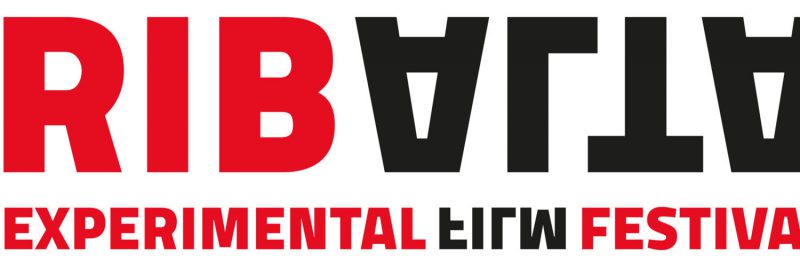
Emulsions – “Metamorphosis of the Gaze”
Ribalta Experimental Film Festival
April 30, 2023
“Metamorphosis of the gaze,” the title of Lynne Sachs’ film staff: from debuts to present days, from the decomposition of movement to time, from gesture to circle. Slitings of the gaze that transfigure the newspaper and make it “visual poetry.”
Planning for EMULSIONS on April 30th at Garagos in collaboration with Nassau Bologna thanks to the availability and generosity of Kino Rebelde. At the end of the screenings Q&A with Lynne Sachs via Zoom moderated by Eduoardo Parasporo and Giovanni Sabattini for translation.
Here are the upcoming titles:
Non è un titolo per niente casuale metamorfosi dello sguardo. Per attraversare un’opera multiforme, ricchissima come quella di Lynne Sachs abbiamo scelto il tema dello sguardo. Come dagli esordi Lynne, nei suoi film, abbia attraversato le soglie del movimento, della “coreografia” (Drawn and Quartered); come, successivamente, riprendendo un gesto originario il reale e la quotidianità nella sua ritualità ed ordinarietà si aprano a sprazzi straordinari e poetici che solo il cinema può donare (Following the Object to Its Logical Beginning, Sound of a Shadow, Drift and Bough) ed infine come abbia fatto delle immagini in movimento una riflessione accorata ed intima sul tempo (Maya at 24). — Giovanni Sabattini
TRANSLATION
This is by no means a casual title Metamorphosis of the Gaze. To traverse a work as multifaceted, as rich as Lynne Sachs’, we have chosen the theme of the gaze. How from the beginning Lynne, in her films, has crossed the thresholds of movement, of “choreography” (Drawn and Quartered); how, subsequently, by taking up an original gesture the real and the everyday in its rituality and ordinariness open up to extraordinary and poetic flashes that only cinema can bestow (Following the Object to Its Logical Beginning, Sound of a Shadow, Drift and Bough); and finally how she has made moving images a heartfelt and intimate reflection on time (Maya at 24). — Giovanni Sabattini

69th International Short Film Festival Oberhausen – Profile programmes
Experimental Cinema
By Marcos Ortega
April 14, 2023
https://expcinema.org/site/en/events/69th-international-short-film-festival-oberhausen-profile-programmes
The 69th International Short Film Festival Oberhausen is presenting five shows of works by filmmakers and artists from different generations and countries who work with the short form in very different ways. They come from the arts, experimental or documentary film, their themes are personal, political or historical, they use performances, collages, text or feature film elements, demonstrating the enormous range and versatility of the short form.
Marcel Broodthaers, Belgium (1924-1976)
A programme of rarely shown cinematic works by the Belgian artist
A poet who decided to become a visual artist at the age of 40, Marcel Broodthaers created a fascinating body of work in a relatively short time, consisting of texts, drawings, paintings, publications, photographs, sculptures, installations – and films. With limited economic and technical means, Broodthaers produced idiosyncratic works that explored the boundaries and rules of film. Oberhausen will be showing a selection that concentrates on Broodthaers’ work as a filmmaker rather than on the exhibition or performance documentaries that were also made. The works are presented in loose chronological order, from Défense de fumer (1967-70) to La Bataille de Waterloo (1975), compiled by curator, scholar and author Xavier García Bardón.
The highlight of the programme is an Expanded Cinema work conceived especially for the festival, presenting projects in which Broodthaers made the screen an integral part of the work. On 28 April, in a special screening outside the cinema hall, a number of his films will be projected onto three special screens. The festival would like to thank Maria Gilissen Broodthaers for her collaboration.
Teboho Edkins (Germany/South Africa)
An agent between cultures
Born in the USA, raised in South Africa and Lesotho and now living in Germany, Teboho Edkins sees himself as a mediator and translator between cultures. His documentary works provide insights into the world of South Africa and Lesotho in particular, be it the gangs of Cape Town in his “gangster trilogy” Gangster Project (2011), Gangster Backstage (2013), and Gangster Film (2020) or the culture of cattle herders in Lesotho as in Shepherds (2020). Both Gangster Backstage and Shepherds won awards at Oberhausen. Edkins’ films are documentary in nature, and he shows them in art contexts as installations as well as at numerous film festivals. In 2020, his feature-length film Days of Cannibalism screened at the Berlinale, and his new short film Ghosts was selected for this year’s International Competition in Oberhausen.
The programme is curated by art historian and curator Susanne Touw.
Alexandra Gulea (Romania)
The first complete show of her short films
Alexandra Gulea was born in Bucharest and studied art in Bucharest and Paris as well as film in Munich. With her expressive, mostly documentary films she has won numerous prizes, including at Oberhausen. Now the festival is showing the first complete show of her short films. She often sheds light on institutional and social constraints, for example in Dumnezeu la Saxofon, Dracu’ la Vioara (The Thumb Twiddlers, 2003), where she portrays the residents of a psychiatric home in Romania, or in Valea Jiului – Notes (2018), which is about the quasi-orphaned children of parents working abroad. Most recently, she won the Prize of the German Competition at Oberhausen with Ńeale azbuirătoare (Flying Sheep, 2022). In the film, she tells the story of her grandparents, who were members of the persecuted Aromanian minority.
Curated by the author, film curator and teacher Madeleine Bernstorff.
Lynne Sachs (USA)
Body of the Body, Body of the Mind
The New York experimental and documentary filmmaker Lynne Sachs is one of the pioneers of feminist experimental film. In around 45 feature and short films to date, she explores the connection between the body, the camera and the materiality of film, mixing personal observation and historical experience, essay, performance, poetry and collage. She won the Grand Prize of the City of Oberhausen in 2020 with A Month of Single Frames; now the festival is presenting a showcase of her work whose central topos is the body. Three programmes, inspired by Sachs’ 2019 poetry collection Year by Year Poems, explore three different approaches: translation, collaboration and the inseparability of the affective and political. Twelve films from 1986’s Drawn and Quartered to Maya at 24 (2021) form a cross-section of Sachs’s work, compiled by publicist, programmer and curator Cíntia Gil.
Lynne Sachs’ new work Swerve has been selected for this year’s International Competition in Oberhausen.
Yamashiro Chikako (Japan)
An international discovery
Born in Okinawa, video artist Yamashiro Chikako is well-known in her home country, but has yet to be discovered in Europe. In Oberhausen, she won the ZONTA Prize for Tsuchi no hito – 2017 gekijyoban (Clay Man – 2017 Film Ver.) in 2018; now the festival is presenting a first show of her work in Europe. Since the 2000s, Yamashiro has been artistically exploring the history, social issues and geopolitical conditions of her homeland. Her focus is above all on the consequences of the American occupation, its cultural influences, the blending of traditional culture and American elements: Ryukyu singing meets Verdi opera, Japanese cowgirls meets spoken word poetry. Curated by Okamura Keiko, curator of contemporary art, Oberhausen shows an overview of Yamashiro’s short film work.
Full festival programme:
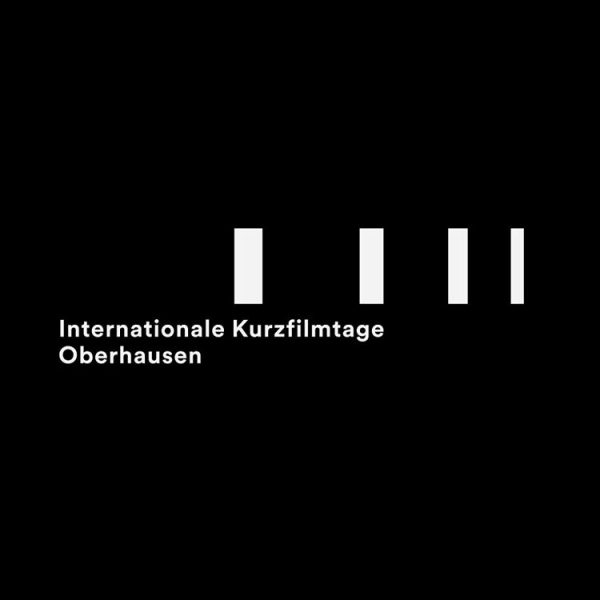
69th Festival: Five Profile programmes Press Release
69th International Short Film Festival Oberhausen
April 13, 2023
https://www.kurzfilmtage.de/en/press/detail/69th-festival-five-profile-programmes/
13.04.2023 Press Press Release News
Five Profile programmes:
Marcel Broodthaers, Teboho Edkins, Alexandra Gulea, Lynne Sachs, Yamashiro Chikako
The 69th International Short Film Festival Oberhausen is presenting five shows of works by filmmakers and artists from different generations and countries who work with the short form in very different ways. They come from the arts, experimental or documentary film, their themes are personal, political or historical, they use performances, collages, text or feature film elements, demonstrating the enormous range and versatility of the short form.
Marcel Broodthaers, Belgium (1924-1976)
A programme of rarely shown cinematic works by the Belgian artist
A poet who decided to become a visual artist at the age of 40, Marcel Broodthaers created a fascinating body of work in a relatively short time, consisting of texts, drawings, paintings, publications, photographs, sculptures, installations – and films. With limited economic and technical means, Broodthaers produced idiosyncratic works that explored the boundaries and rules of film. Oberhausen will be showing a selection that concentrates on Broodthaers’ work as a filmmaker rather than on the exhibition or performance documentaries that were also made. The works are presented in loose chronological order, from Défense de fumer (1967-70) to La Bataille de Waterloo (1975), compiled by curator, scholar and author Xavier García Bardón.
The highlight of the programme is an Expanded Cinema work conceived especially for the festival, presenting projects in which Broodthaers made the screen an integral part of the work. On 28 April, in a special screening outside the cinema hall, a number of his films will be projected onto three special screens. The festival would like to thank Maria Gilissen Broodthaers for her collaboration.
Teboho Edkins (Germany/South Africa)
An agent between cultures
Born in the USA, raised in South Africa and Lesotho and now living in Germany, Teboho Edkins sees himself as a mediator and translator between cultures. His documentary works provide insights into the world of South Africa and Lesotho in particular, be it the gangs of Cape Town in his “gangster trilogy” Gangster Project (2011), Gangster Backstage (2013), and Gangster Film (2020) or the culture of cattle herders in Lesotho as in Shepherds (2020). Both Gangster Backstage and Shepherds won awards at Oberhausen. Edkins’ films are documentary in nature, and he shows them in art contexts as installations as well as at numerous film festivals. In 2020, his feature-length film Days of Cannibalism screened at the Berlinale, and his new short film Ghosts was selected for this year’s International Competition in Oberhausen.
The programme is curated by art historian and curator Susanne Touw.
Alexandra Gulea (Romania)
The first complete show of her short films
Alexandra Gulea was born in Bucharest and studied art in Bucharest and Paris as well as film in Munich. With her expressive, mostly documentary films she has won numerous prizes, including at Oberhausen. Now the festival is showing the first complete show of her short films. She often sheds light on institutional and social constraints, for example in Dumnezeu la Saxofon, Dracu’ la Vioara (The Thumb Twiddlers, 2003), where she portrays the residents of a psychiatric home in Romania, or in Valea Jiului – Notes (2018), which is about the quasi-orphaned children of parents working abroad. Most recently, she won the Prize of the German Competition at Oberhausen with Ńeale azbuirătoare (Flying Sheep, 2022). In the film, she tells the story of her grandparents, who were members of the persecuted Aromanian minority.
Curated by the author, film curator and teacher Madeleine Bernstorff.
Lynne Sachs (USA)
Body of the Body, Body of the Mind
The New York experimental and documentary filmmaker Lynne Sachs is one of the pioneers of feminist experimental film. In around 45 feature and short films to date, she explores the connection between the body, the camera and the materiality of film, mixing personal observation and historical experience, essay, performance, poetry and collage. She won the Grand Prize of the City of Oberhausen in 2020 with A Month of Single Frames; now the festival is presenting a showcase of her work whose central topos is the body. Three programmes, inspired by Sachs’ 2019 poetry collection Year by Year Poems, explore three different approaches: translation, collaboration and the inseparability of the affective and political. Twelve films from 1986’s Drawn and Quartered to Maya at 24 (2021) form a cross-section of Sachs’s work, compiled by publicist, programmer and curator Cíntia Gil.
Lynne Sachs’ new work Swerve has been selected for this year’s International Competition in Oberhausen.
Yamashiro Chikako (Japan)
An international discovery
Born in Okinawa, video artist Yamashiro Chikako is well-known in her home country, but has yet to be discovered in Europe. In Oberhausen, she won the ZONTA Prize for Tsuchi no hito – 2017 gekijyoban (Clay Man – 2017 Film Ver.) in 2018; now the festival is presenting a first show of her work in Europe. Since the 2000s, Yamashiro has been artistically exploring the history, social issues and geopolitical conditions of her homeland. Her focus is above all on the consequences of the American occupation, its cultural influences, the blending of traditional culture and American elements: Ryukyu singing meets Verdi opera, Japanese cowgirls meets spoken word poetry. Curated by Okamura Keiko, curator of contemporary art, Oberhausen shows an overview of Yamashiro’s short film work.
Full festival programme:
https://kurzfilmtage.filmchief.com/shop/tickets
Download stills:
https://www.kurzfilmtage.de/en/press/#c261
Accreditation deadline: 17 April 2023
https://www.kurzfilmtage.de/en/visit/#t2638
Oberhausen, 14 April 2023
Press contact: Sabine Niewalda, T +49 (0)208 825-3073, niewalda@kurzfilmtage.d

Lynne Sachs Profile
69th Oberhausen Short Film Festival
May 1, 2023
Program 1 – [girls with fast lane dreams]: https://kurzfilmtage.filmchief.com/shop/tickets?v=1493
Program 2 – [Another baby girl drops down]: https://kurzfilmtage.filmchief.com/shop/tickets?v=1494
Program 3 – [scars muscles curves of the spine]: https://kurzfilmtage.filmchief.com/shop/tickets?v=1495
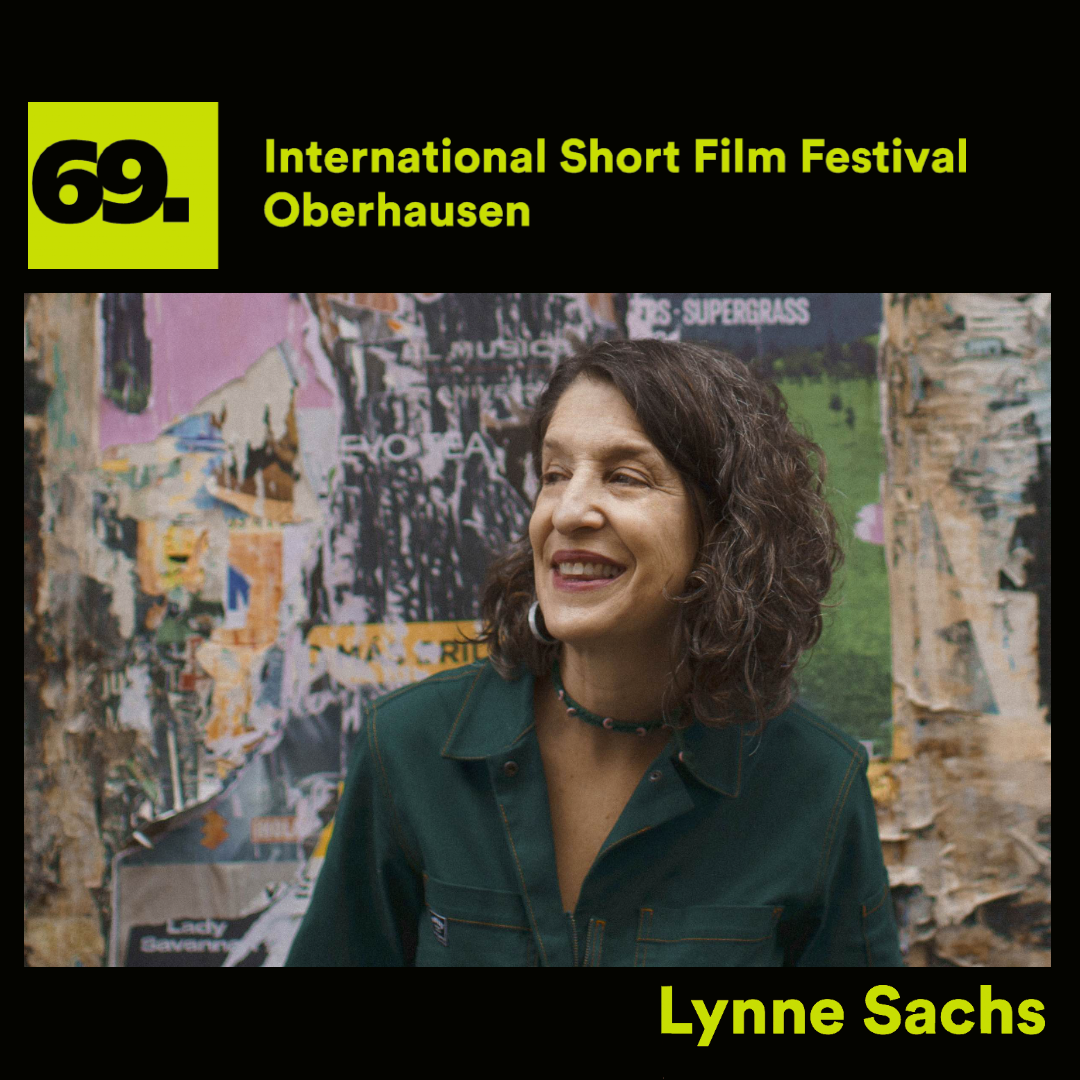
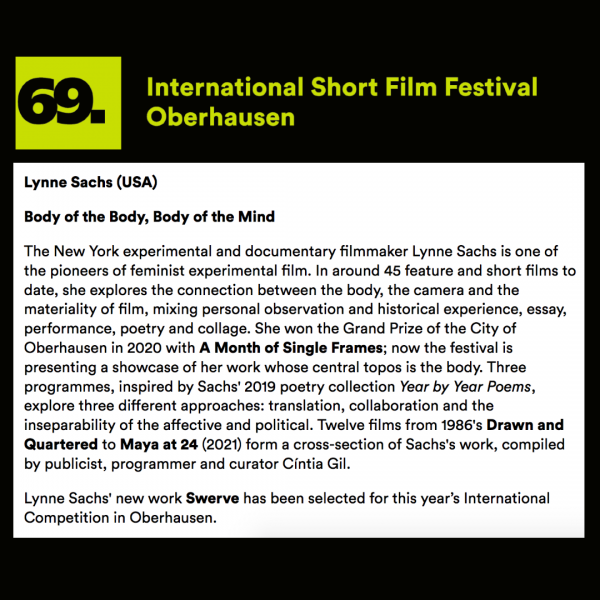
An overview of the films of the New York pioneer of experimental documentary. Sachs’ films are inseparably linked to events of life, though they are resolutely non-biographical. Inspired by her poetry collection Year by Year Poems, the central “topos” of these programmes is the body (and the bodies „in-between“). The negotiation between the body of the body and the body of the mind leads from the Vietnam War to feminism to death.
A Month of Single Frames
Lynne Sachs
USA, 2019
In 2018, Barbara began her own process of dying by revisiting her archive. She gave her Duneshack materials to Lynne. ‘The words on the screen came to me in a dream. I was really trying to figure out a way to talk to the experience of solitude that Barbara had had, how to be there with her somehow through the time that we would all share together watching her and the film.’
Noa, Noa
Lynne Sachs
USA, 2006
Over the course of three years, Sachs collaborated with her daughter Noa (from 5 to 8 years old), criss-crossing the wooded landscapes of Brooklyn with camera and costumes in hand. Noa’s grand finale is her own rendition of the bluegrass classic ‘Crawdad Song’.
Drift and Bough
Lynne Sachs
USA, 2014
A winter morning in a Central Park covered in snow. Graphic explosions of dark and light and an occasional skyscraper. The black lines of the trees against the whiteness become an emotional drawing. Stephen Vitielloʼs delicate yet soaring musical track seems to wind its way across the frozen ground, up the tree trunks to the sky.
Which Way is East: Notebooks from Vietnam
Lynne Sachs
USA, 1994
Lynne and her sister Dana travelled from Ho Chi Minh City to Hanoi. Their conversations with strangers and friends reveal to them the flip side of a shared history. Lynne and Dana’s travel diary revels in the sounds, proverbs, and images of daily life. Their film becomes a warm landscape that weaves together stories of people they met with their own childhood memories of the war on TV.
The House of Science: a museum of false facts
Lynne Sachs
USA, 1991
Combining home movies, personal remembrances, staged scenes and found footage into an intricate visual and aural collage, the film explores the representation of women and the construction of the feminine otherness. A girl’s sometimes difficult coming-of-age rituals are recast into a potent web for affirmation and growth.
Drawn and Quartered
Lynne Sachs
USA, 1986
Optically printed images of a man and a woman fragmented by a film frame that is divided into four distinct sections. An experiment in form/content relationships that are peculiar to the medium. A declaration of desire of and through cinema.
Maya at 24
Lynne Sachs
USA, 2021
‘My daughterʼs name is Maya. Iʼve been told that the word maya means illusion in Hindu philosophy. I realized that her childhood was not something I could grasp but rather – like the wind – something I could feel tenderly brushing across my cheek.’ Lynne filmed Maya at ages 6, 16 and 24, running around her, in a circle – as if propelling herself in the same direction as time, forward.
A Biography Of Lilith
Lynne Sachs
USA, 1997
Off-beat narrative, collage and memoir, updating the creation myth by telling the story of the first woman. Lilith’s betrayal by Adam in Eden and subsequent vow of revenge is recast as a modern tale. Interweaving mystical texts from Jewish folklore with interviews, music and poetry, Sachs reclaims this cabalistic parable to frame her own role as a mother.
The Task of the Translator
Lynne Sachs
USA, 2010
Three studies of the human body compose an homage to Benjamin’s The Task of the Translator. Musings of a wartime doctor grappling with the task of a kind of cosmetic surgery for corpses. A group of classics scholars confronted with the task of translating an article on Iraqi burial rituals into Latin. A radio news report on human remains.
The X Y Chromosome Project
Mark Street, Lynne Sachs
USA, 2007
Sachs and her partner Mark Street use the split screen to cleave the primordial to the mediated. Their diptych structure transforms from a boxing match into a pas de deux. Newsreel footage brushes up against hand painted film, domestic spaces, and movie trailers. Together, Sachs and Street move from surface to depth and back again.
Starfish Aorta Colossus
Lynne Sachs
USA, 2015
Poetry watches film. Film reads poetry. Paolo Javier’s text is a catalyst for the digital sculpting of an 8 mm Kodachrome canvas. Syntactical ruptures and the celebration of nouns. Paolo Javier invited Lynne to create a film that would speak to one of his poems. She travels through 25 years of her 8 mm films.
The Last Happy Day
Lynne Sachs
USA, 2009
In 1938, Sandor Lenard, a Hungarian doctor, fled from the Nazis to Rome. Shortly thereafter, the U.S. Army hired him to reconstruct the bones of dead American soldiers. Eventually he moved to Brazil where he embarked on the translation of Winnie the Pooh into Latin. The film weaves together personal letters, abstracted war imagery, home movies, interviews, and a children’s performance.
BODY OF THE BODY, BODY OF THE MIND
Lynne Sachs Artist Profile
April 26 – May 1, 2023
69th International Short Film Festival Oberhausen
Curator: Cíntia Gil
Program notes by Cíntia Gil:
The title of this retrospective quotes Lynne Sachs in her 1991 film “The House of Science: a museum of false facts”. It speaks of a zone of experimentation that crosses Sachs’ work and grounds filmmaking as a practice of dislocating words, gestures and modes of being into open ontologies. What can be a woman, a word, a color, a shade, a line, a rule or an object? The negotiation between the body of the body and the body of the mind is another way of saying that things exist both as affections and as processes of meaning, and that filmmaking is the art of not choosing sides in that equation. That is why Sachs’ work is inseparable from the events of life, while being resolutely non-biographical. It is a circular, dynamic practice of translation and reconnection of what appears to be separated.
There are many ways of approaching Lynne Sachs’ full body of work, and many different programmes would have been possible for this retrospective. Films resonate among each other. Like threads, themes link different times. Repetition and transformation are a constant obsession in the way images, places, people and ideas are revisited. While looking for an angle for this programme, I tried to look at some of the threads that seem to me the most constant, even if sometimes subterraneous, throughout the films. The three programmes are not systematically bound by themes or built around typologies. There are three different doors to the same arena where body (and the ‘in-between’ bodies) is the main ‘topos’: translation, collaboration, and inseparability of the affective and the political. Yet, none of these terms seems to truly speak of what’s at stake here.
Lynne Sachs knows about the disequilibrium that happens between words and concepts, and about the difference between the synchronicity of life and the linearity of discourse. She also knows that words can be both symptoms and demiurgic actors. That is maybe why she writes poems, and why this programme was inspired by her book, “Year By Year Poems”[1].
1975 [girls with fast lane dreams]
Teachers push us to the precipice –
trick us with conundrums we mistake for algorithms
catch us in a maelstrom of dizzying numbers.
Searching for the exit door
I discover quick methods for finding north –
solace in the gravitational pull of geography
and head for the first opening from a school
with too many ambitions
penalty points
and girls with fast-lane dreams.
Talking about the making of “Which Way is East”, Lynne Sachs said: “the most interesting films are the ones that ask us to think about perception, that don’t just introduce new material.”[2]. Both Lynne Sachs and her sister Dana, a writer, lived the Vietnam War through television – a middle-class childhood sometimes haunted by images of that war that seemed both far away and fundamental to their generation. When Dana moved to Vietnam in the early 1990s, Lynne visited for a month, and they made a film. The film begins with a sequence of movement shots, colors, fleeting forms, interrupted by a popular Vietnamese saying about a frog and the horizon. Three layers come together, predicting one of the strongest traits of Lynne’s work: the world seen through the rhythm of a moving body, and the dialogue between different modes of feeling and thinking. [Lynne’s childhood Vietnam War images were black and white, upside down; the Vietnam landscape in 1991 is crossed on a motorbike, and nature is motion and strangeness; “a frog sitting on the bottom of a well, thinks the whole sky is only as big as the lid of a pot”.]
A travelog in Vietnam became a dialogue of perceptive discoveries, glimpses of meaning and, most importantly, of the many ways of being just here and now, together, facing abysses that should not eat us alive. How to not be eaten alive by life’s infinite and sublime abysses?
Girls with fast-lane dreams is another way of referring to an impulse for joy.
Girls looking at girls, girls playing with girls, Lynne Sachs and Barbara Hammer collaborating on an impossible film. How to work on beauty, without monumentalizing it? How to work on death without freezing the life within? A kid once told me: “you have to pass it through the inside, and let it out through your smart eye”. Is that translation? Isn’t “A Month of Single Frames” the translation of a place and a body, the conditions of light seen through embodied solitude?
There is some kind of radical positioning of Lynne Sachs’ gaze (gaze is a pace and a gesture, and that is its politics): allowing things to unfold as they are, knowing that it is the very act of filming them that constitutes their becoming. Noa becomes play with light. Maya becomes time and unsurmountable individuality. Central Park becomes a porous membrane for the circulation between a musical movement and the event of an emotional form.
1997 [Another baby girl drops down]
(for my daughter, Noa)
Again, nine full moons leave bare
the dust against the sky.
Air fills up with brightness.
Another baby girl drops down.
Dice on a betting table
or rich, ripe fruit atop worn grass.
The political comes forward when things are dislocated from their assigned places, becoming eloquent. When a field of possibilities is problematized by different temporalities, different meanings attach to the same words. New symptoms (not symbols) emerge from the same myths. To the territorialization of body, Lynne Sachs responds with the unspeakable layers of desire, underpinning the history of the body. To the typification of identity, cinema responds with the history of gesture.
Feminism in Lynne Sachs’ work comes from an obsession with ontological fluidity – women as possibilities, bringing with them the memory of what has not been captured by politics, the promise of kinder political places. Such invention requires the deconstruction of the gaze, the transformation of language through the power of a thinking (collective) body. Collective as in-between, in circulation, in transition with others: the Lilliths who may or not become mothers in “A Biography of Lillith”, the enfolding body in “Drawn and Quartered”, the collage that renders old measures useless in “The House of Science: a museum of false facts”.
Materiality is a key aspect in this cinema, it sustains the emergence of a filmic gesture. The presence of things in their most concrete form, be it a birth, a hand helping to translate an idea, a splash of light on a face, the astonishment of a baby in front of a camera. Things occupy a certain space, move in a certain way, and their sensuality is never sublimated or forced into metaphors. It is their material presence that saves them from their assigned roles and chains of meaning, revealing their vitality as a principle for a political imagination.
“Incendiary, but not arson.”[3]
2009 [scars muscles curves of the spine]
I hold the mirror just inches away and look
shy
detached
brave
I touch myself with knowledge
Scars muscles curves of the spine
I trace a path across my chest
searching for surprises I’d rather not find –
knots in the fabric
Translation comes, then, as a movement between transmitted memory, embodied experience, affective vocabulary and the never-accomplished labor of form. Nothing stays determined within a field of possibilities, but the field itself is in a constant motion, resignifying every aspect, reconnecting every moment in time, every glimpse of an image. The work done around Sandor Lenard, a distant cousin, seems key to consider her full body of work. “The Task of the Translator”, presents three movements, three ways of looking for the body. It starts with the reassemblage of bones of dead American soldiers during WWII by Sandor Lenard, in a sequence that will come back in “The Last Happy Days”. Here, translation is both an effort to make sense of the materiality of time and history, and a question about the translatability of such. Like in “Which Way is East”, how can history be translated through the gestures of the present, of the living? Is the way the past escapes linearity and expresses its vitality?
The second movement in “The Task” shows a group of scholars translating an article on Iraqi burial rituals into Latin. Tentative words and articulations around a table, hands helping meaning through gestures. Is Latin a dead language? Sandor Lenard, after moving to Brazil, translated Winnie the Pooh into Latin. What paradox lies in the gesture of translating a children’s story into a dead language? Translation is a game of materiality, of dislocating the world into another regime of forms and movements. Allowing language to pass through the materiality of the present time. In “The Last Happy Day”, children tell the story of Sandor Lenard while rehearsing Winnie the Pooh. Translatability through bodies and gestures, vitality: one does not simply look at the past, but rather invents a dialogue of embodied time. In “The Task of the Translator”, suddenly the camera leaves the scholars and focuses on the drops of rain on a foggy window, and on the gestures of a hand, before we start hearing radio news about human remains after an attack.
Translation keeps all things alive at the same time – even the matter of death.
Cíntia Gil
Born in Portugal, Cíntia Gil studied at the Escola Superior de Teatro e Cinema (Lisbon Theatre and Film School) and holds a degree in Philosophy from the Faculdade de Letras da Universidade do Porto (Faculty of Arts and Humanities at the University of Porto). From 2012 to 2019, Cíntia Gil served as co-director and then director of Doclisboa – International Film Festival. From 2019 to 2021 she has directed Sheffield DocFest in England. In 2022, Cíntia started the programme of screenings and study groups “Artistic Differences”, at UnionDocs (NY), as a co-curator together with Jenny Miller and Christopher Allen. She is part of the programming team of Cannes Directors Fortnight.
Gil has curated a variety of contemporary and historical film series, retrospectives and exhibitions, besides publishing articles in various publications. In addition, she has taught seminars, lectures and workshop in different institutions (Centro de Capacitación Cinematográfica in Mexico, EICTV in Cuba, HGK Karlsruhe University of Arts and Design in Germany among others), and she is a project tutor for the Master on Creative Documentary at the Pompeu Fabra University . She has also served on juries in international film festivals, such as Berlinale, Cairo Film Festival, Mar del Plata, Jerusalem Film Festival, Torino Film Festival, London Film Festival, IDFA, Taipei IDF, FidMarseille, Seville European Film Festival, DokuFest, Ficunam, DocsNYC, Guadalajara, among many others. She has been a member of the executive Board of Apordoc – Associação pelo Documentário, the Portuguese documentary film association since 2015.
[1] Lynne Sachs, “Year by Year Poems”, Tender Buttons Press, NY, 2019
[2] “Observe and Subvert”, interview by Inney Prakash for Metrograph, December 2021
[3] In “The House of Science: a museum of false facts”.

Artistic Differences: Body of the Body, Body of the Mind
Union Docs
April 15, 2023
https://uniondocs.org/event/artistic-differences-body-of-the-body-body-of-the-mind/
Apr 15, 2023 at 3:00 pm
Artistic Differences:
BODY OF THE BODY, BODY OF THE MIND
This program is part of Artistic Differences with Internationale Kurzfilmtage Oberhausen
ARTISTIC DIFFERENCES is back with Internationale Kurzfilmtage Oberhausen this April to present BODY OF THE BODY, BODY OF THE MIND.
Co-curator Cíntia Gil has assembled a mini-retrospective at this year’s festival on one of our longtime collaborators, the beloved and brilliant Lynne Sachs. We’re delighted to focus on one of these three programs for an upcoming Study Group on April 15th from noon-2:30PM Est.
The title of this retrospective and program quotes Lynne Sachs in her 1991 film The House of Science: A Museum of False Facts. It speaks of a zone of experimentation that crosses Sachs’ work and grounds filmmaking as a practice of dislocating words, gestures and modes of being into open ontologies. What can be a woman, a word, a color, a shade, a line, a rule or an object? The negotiation between the body of the body and the body of the mind is another way of saying that things exist both as affections and as processes of meaning, and that filmmaking is the art of not choosing sides in that equation. That is why Sachs’ work is inseparable from the events of life, while being resolutely non-biographical. It is a circular, dynamic practice of translation and reconnection of what appears to be separated.
There are many ways of approaching Lynne Sachs’ full body of work, and many different programmes would have been possible for this retrospective. Films resonate among each other. Like threads, themes link different times. Repetition and transformation are a constant obsession in the way images, places, people and ideas are revisited. While looking for an angle for this programme, we tried to look at some of the lines that seem to us the most constant, even if sometimes subterraneous, throughout the films. The three programmes are not systematically bounding themes and building typologies. They are three different doors to the same arena where body (and the ‘in-between’ bodies) is the main ‘topos’: translation, collaboration, and inseparability of the affective and the political. Yet, none of these terms seems to truly speak of what’s at stake here.
Lynne Sachs knows about the impotency problem of words and concepts, about the difference between the synchronicity of life and the linearity of discourse. She also knows that words can be both symptoms and demiurgic actors. That is maybe why she wrote poems, and that is why this programme was inspired by her book, “Year By Year Poems”.
Sign up for the Study Group to join this dialogue and ever-growing international community!
FILM PROGRAM
The House of Science: A Museum of False Facts by Lynne Sachs
30 min | 16mm | Color | 1991
Combining home movies, personal remembrances, staged scenes and found footage into an intricate visual and aural collage, the film explores the representation of women and the construction of the feminine otherness. A girl’s sometimes difficult coming of age rituals are recast into a potent web for affirmation and growth.
Drawn and Quartered by Lynne Sachs
4 min | 16mm | Color | Silent | 1986
Optically printed images of a man and a woman fragmented by a film frame that is divided into four distinct sections. An experiment in form/content relationships that are peculiar to the medium. A declaration of desire of and through cinema.
Maya at 24 by Lynne Sachs
4 min | 16mm to Digital Transfer | B&W | 2021
“My daughterʼs name is Maya. Iʼve been told that the word maya means illusion in Hindu philosophy. I realized that her childhood was not something I could grasp but rather – like the wind – something I could feel tenderly brushing across my cheek.” Lynne filmed Maya at ages 6, 16 and 24, running around her, in a circle – as if propelling herself in the same direction as time, forward.
A Biography of Lilith by Lynne Sachs
35 min | 16mm | Color | 1997
Off-beat narrative, collage and memoir, updating the creation myth by telling the story of the first woman. Lilith’s betrayal by Adam in Eden and subsequent vow of revenge is recast as a modern tale. Interweaving mystical texts from Jewish folklore with interviews, music and poetry, Sachs reclaims this cabalistic parable to frame her own role as a mother.
STUDY GROUP — ONLINE – APR 15
We’re thrilled to come together for a Study Group Session structured around these incredible films! Like a kind of grassroots book club, but for documentary art, it’s all about sparking discussion and deeper investigation, through reading, listening and responding in small, self-organized groups that together form a larger collective experience.
You will get access to the film program through our Membership Hub a few days in advance. Sign up now and stay tuned in your inbox for further instructions!
PUBLIC DIALOGUE – AT THE FESTIVAL – APR 30 – MAY 1
If you’re interested in hearing from the filmmakers & artists themselves as well as the ideas generated in collaboration with our Study Group be sure to catch our regular public dialogues for each film program on the UNDO Member’s Hub. These conversations sample from the festival dialogues, the study group and an in-depth interview hosted by Artistic Differences with the featured artists. Sign Up to receive a note when it’s released.
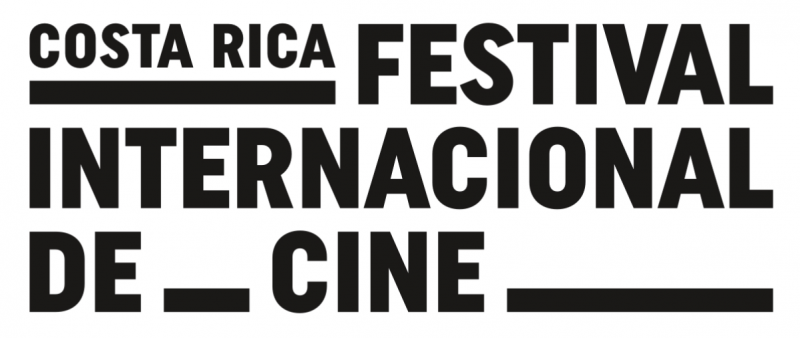
Interview with Lynne Sachs
Costa Rica International Film Festival, Lynne Sachs Retrospective
Interviewed by Roberto Jaén – Director, Curator of the Preambulo project of the Costa Rican Center for Film Production
June 17, 2022
https://www.youtube.com/watch?v=lYv9cFkM4Iw&t=3s
The American filmmaker and poet Lynne Sachs was honored by the tenth edition of the Costa Rica International Film Festival. 10CRFIC paid tribute to Sachs in a retrospective on her work featuring 14 of her films, characterized by Sachs’ poetic, intimate, experimental and reflective tone. In this interview, she tells us how she began her craft and her love for cinema.
Credits
Executive Production: Film Center of the Ministry of Culture
Production Coordinator: Vania Alvarado
Producer: Luis Alonso Alvarez
Photography: Jorge Jaramillo
Camera assistant: Diego Hidalgo and Gabriel Marín
Direct Sound: David Rodríguez
Editing: David Rodriguez – Diego Hidalgo
Interviewer: Roberto Jaen